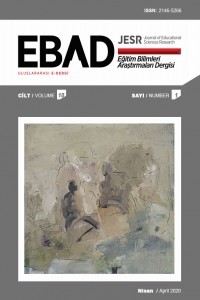[Türkçe ders kitaplarındaki metinlerde özü bulma ve ilişkilendirme]
Özü bulma, Derin anlam, Ana fikir, Türkçe ders kitapları
Finding and associating the core in the texts within Turkish textbooks
Core in the Texts, Deep meaning, Main idea, Turkish Textbooks,
___
- Baş, Ö. & Kardaş, N. (2014). İlköğretim öğrencilerinin görsel okuma becerisi ile okuduğunu anlama becerisi arasındaki ilişkinin incelenmesi. Uşak Üniversitesi Sosyal Bilimler Dergisi, 7(1), 230-243.
- Batur, Z. (2013). The analysis of the level of students’ perception of the messages in fictive texts in fictional context. Reading Improvement, 50(2), 61-70.
- Çetinkaya, Ç., Ateş, S., & Yıldırım, K. (2013). Difficult and curial skill in making meaning: finding main idea. Journal of Theory and Practice in Education, 9(3), 188-210.
- Doğan, B. (2015). Okuma ve görsel okumanın bir metnin ana düşüncesini bulma ile metni analiz etme üzerine etkilerinin belirlenmesi. Erzincan Üniversitesi Sosyal Bilimler Enstitüsü Dergisi, (Special Issue 2), 67-84.
- Erçapan, C. (2009). Okuduğunu anlama stratejilerine genel bir bakış. Uluslararası Sosyal Araştırmalar Dergisi, 2(6), 207-223.
- Jitendra, A. K., Cole, C. L., Hoppes, M. K., & Wilson, B. (1998). Effects of a direct instruction main idea summarization program and self‐monitoring on reading comprehension of middle school students with learning disabilitıes. Reading & Writing Quarterly, 14(4), 379-396.
- Jitendra, A. K., Hoppes, M. K., & Xin, Y. P. (2000). Enhancing main idea comprehension for students with learning problems: the role of summarization strategy and selfmonitoring instruction. Journal of Special Education, 34(3), 127-139.
- Kerkhoff, I. (1973). Angewandte textwissensschaft. Düsseldorf: Bertelsmann Universitaetsverlag.
- Kush, J. C., Watkins, M. W., & Brookhart, S. M. (2005). The temporal-interactive influence of reading achievement and reading attitude. Educational Research and Evaluation, 11(1), 29-44.
- Kuşdemir, Y., & Katrancı, M. (2016). Okumada kaygı ve anlama: Ana fikri bulamıyorum öğretmenim! Eğitim ve Bilim, 183, 251-266.
- Lawton, D. (1970). Social class, language and education. London: Western Printing Services Ltd. Bristol.
- Özbay, M., & Özdemir, B. (2012). Okuduğunu anlama sürecinde çıkarım yapma becerisinin işlevi. Mustafa Kemal Üniversitesi Sosyal Bilimler Enstitüsü Dergisi, 9(18), 17-28.
- Pilten, G. (2007). Ana fikir bulma stratejisi öğretiminin ana fikir bulma ve okuduğunu anlamaya etkisi (Unpublished doctoral dissertation). Gazi University, Ankara.
- Temizkan, M. (2009). Metin türlerine göre okuma eğitimi. Ankara: Nobel.
- Wygotski, L. S. (1971). Denken und sprechen. Stuttgart: Union Druckerei GmbH. Yılmaz, M. (2008). Türkçede okuduğunu anlama becerilerini geliştirme yolları. Mustafa Kemal Üniversitesi Sosyal Bilimler Enstitüsü Dergisi, 5(9), 131-139.
- Başlangıç: 2011
- Yayıncı: Kürşad YILMAZ
Yusuf İNANDI, Ayşe UZUN, Hayriye YEŞİL
[Oyuncak kütüphanesi: Bir fenemonoloji araştırması]
[Yabancı dilin İngilizce olarak öğretildiği sınıflarda yüksek ya da düşük bağlamlı kültür?]
[Sınıf öğretmeni adaylarının akademik erteleme davranışını yordayan değişkenler]
Asuman Seda SARACALOĞLU, İbrahim GÖKDAŞ
[Öğrenme stilleri ve bazı demografik faktörlerin öğrenme stratejileri üzerindeki etkisi]
Erdoğan TEZCİ, Neriman ATASEVEN
[Ortaöğretim kurumlarında bilgi uçurma ve örgütsel vatandaşlık davranışları arasındaki ilişki]
Emrah GÜL, Çilem Doğan GÜL, Ömay ÇOKLUK, Murat KAYRİ
[Türkçe ders kitaplarındaki metinlerde özü bulma ve ilişkilendirme]
Mustafa Volkan COŞKUN, Didem ÇETİN
[Yaratıcı drama yönteminin derse yönelik tutuma etkisi: Bir meta analiz çalışması]
